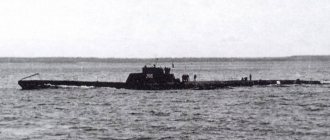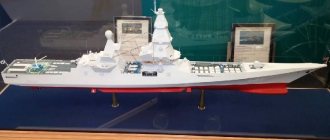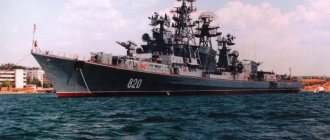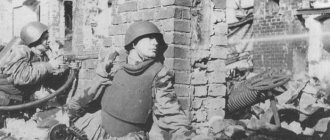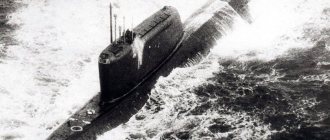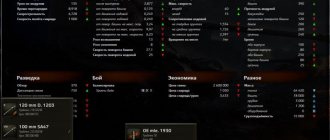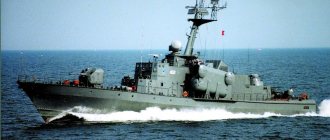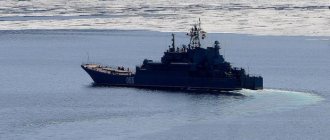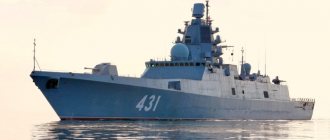Characteristics of patrol ships of the "Hurricane" type.
A country:USSRType:Patrol shipDate of issue:Launched in 1930 (sometimes written 1927)Displacement:from 467 to 619 tons for various ships of the series, in different yearsLength:71.5 mWidth:7.4 mDraft:2.3-2.8 mReservations:NoCrew:108 peoplePower point:2 boiler-turbine power plants, 6820 hp, the power spread of individual units exceeded 1000 hp.Travel range:1200 miles at 14 knotsMaximum speed:Design - 26 knots, real is always 2-3 knots lessWeapons:2×1 102 mm guns, 4×1 45 mm (or 3×37 mm machine guns), three-tube 450 mm torpedo tube, 2 bomb launchers (up to 48 min, 30 depth charges), paravane trawlAir group:No
The first surface combat vessels built by the USSR were Uragan-class patrol ships . Initially, the series of these ships did not even have their own project number, but when TsKBS-1 was formed in January 1932, all work on fine-tuning the Hurricanes was transferred to this organization. Since the patrol ship project became the second for the bureau (after the leaders of the Leningrad class), it was retroactively assigned project number 2.
The question of creating a series of small escort ships with a displacement of 350 - 400 tons arose in the early 1920s. immediately after the end of the civil war. It would seem that the construction of such small ships for a country that less than ten years ago mass-produced super-dreadnoughts with a displacement of 32.5 thousand tons cannot be something extraordinary. But, in practice, it really turned out to be “a completely different country.”
The best engineers and designers either left Russia for civilian life or died on its fronts. The shipbuilding experience that the empire had accumulated over centuries was irretrievably lost. In conditions of acute personnel shortage, people with at least some experience were appointed to responsible positions. This is evidenced by the fact that in 1927, 33-year-old engineer V.A. Nikitin , who graduated from the Leningrad Polytechnic Institute just two years ago!
Is it necessary to note after this that Project No. 2, so important for the country, was, to put it mildly, not without design flaws?
Recommendations
- Breuer, Siegfried (1992). Development of Soviet Warships: Volume 1: 1917–1937.
. London: Conway Maritime Press. ISBN 0-85177-604-3. - Budzbon, Przemyslaw; Lemachko, Boris (1982). "Bad Weather Flotilla" Warship
.
London: Conway Maritime Press. VI
(22–4): 140–5, 198–203, 292–8. ISBN 0-87021-981-2. - Roger Chenault, ed. (1980). Conway's Fighting Ships of the World 1922–1946
. Greenwich: Conway Maritime Press. ISBN 0-85177-146-7. - Hill, Alexander (2018). Soviet destroyers of World War II
. Oxford: Osprey Publishing. ISBN 9781472822567. - Rover, Jurgen (2005). Chronology of War at Sea 1939–1945: A Naval History of the Second World War
(Third Revised Edition). Annapolis, MD: Naval Institute Press. ISBN 1-59114-119-2. - Whitley, M. J. (1988). Destroyers of World War II
. Cassell Publishing. ISBN 1-85409-521-8.
Construction of the lead patrol ship "Hurricane"
Construction of the lead ship was completed at the end of the summer of 1930, and on August 27, it was tested for stability in the waters of the Northern Shipyard. With a bow draft of 1.60 m and a stern of 1.75 m, which corresponded to a displacement of 328 tons, the initial transverse metacentric height was 0.54 m. Exactly a month later, on September 27, the ship with the factory crew made its first, albeit short-lived, exit in the sea. 5 miles were covered and 7.9 tons of oil were consumed. On September 30, an artillery test was carried out, with 11 shots fired from each 102-mm gun. The total capacity of the bow and stern magazines was determined to be 408 rounds.
"Thunderstorm" - one of the "hurricanes" during the Second World War
On October 22, the Hurricane went to sea for factory sea trials. Since they received only 485 rpm of propeller shafts instead of the required 630, the tests were repeated the next day. This time the number of revolutions per minute was 540... It was difficult to call it a success, but in the absence of anything else, the ship was shown to the selection committee.
On October 27, the tests continued - the ship with members of the commission on board went to sea to conduct 4-hour tests at full speed. When surveyed from anchor, the draft was 2.28 m bow and 2.16 m stern, which corresponded to a displacement of 484 tons, and this was 84 tons (that is, 21%!) higher than the design. In total, the Hurricane completed four runs on a measured mile between the Nerva and Big Somers lighthouses. The average speed was 25.78 knots at 577 rpm propellers. The average gross power measured at the turbine couplings with Chatbourne torsiometers was found to be 6820 hp. During the test, the ship traveled 288 miles and consumed 34 tons of fuel.
At the beginning of November, training firing was carried out, and during the final tests on November 22, 1930, at least they managed to repeat the results from the 27th. At this point, the Hurricane tests were completed. The test report stated that the design parameters of the project were: speed of 29 knots with a total gross turbine power of 7500 hp. and a displacement of 400 tons were not achieved. There were also no 37 mm belt-fed machine guns, 12.7 mm machine guns or a radio station. The smoke screen, the device for dropping depth charges and the paravanes were also not tested, due to the fact that they simply did not have time to be manufactured and installed on time.
Same camouflage as in the photo above, but this time it's "Storm"
December 9 Namorsi R.A. Muklevich imposed a resolution on the test report: “I approve. The vessel is accepted conditionally. During the winter, eliminate all defects that affect the speed and achieve its increase. The achieved results are considered unacceptable,” and on December 14, in the waters of the Northern Shipyard, a ceremonial raising of the naval flag took place on the Hurricane, after which it was enlisted in the division of patrol ships of the Naval Forces of the Baltic Sea.
Unfortunately, neither over the winter, nor the next year, nor even on all the subsequent 5 ships of the 1st series of Project No. 2, the noted defects were eliminated. Moreover, starting from the third ship (“Smerch”), they even stopped noting this fact in the acts.
However, with the launch of the Whirlwind (the 6th ship), the commission nevertheless called on the shipbuilders, if not to answer, then at least to take their heads: “It is proposed that the Northern Shipyard and TsKBS-1 answer the question about the reasons for the lack of speed at all patrol ships, supported by digital materials.” Serious debriefing began.
Notes
- ^ a b
Budzbon and Lemachko, p. 143 - Budzbon and Lemachko, p. 140–3.
- ^ a b
Budzbon and Lemachko, p. 199 - Budzbon and Lemachko, pp. 143–4.
- ^ a b c d
Budzbon and Lemachko, p. 144 - Budzbon and Lemachko, pp. 144–5, 198–9.
- Budzbon and Lemachko, pp. 144–5.
- Budzbon and Lemachko, p. 145
- Budzbon and Lemachko, p. 144, 198.
- Breuer, page 187
- ^ a b
Budzbon and Lemachko, p. 201 - Breuer, page 189
- Budzbon and Lemachko, p. 202
- Polmar, Norman; Jurrien Nuth (1991). Submarines of the Russian and USSR Navy, 1718–1990.
. Naval Institute Publishing House. paragraph 95. ISBN 0-87021-570-1. - ^ a b
Budzbon and Lemachko, p. 203 - Budzbon and Lemachko, p. 292
- ^ a b c
Wheatley, page 241 - Rohwer, pp. 86, 95
- Germany. Kriegsmarine; United States. Office of Naval Intelligence. War diary of the admiral, Black Sea, October 1, 1942 - December 31, 1942
. Henry E. Eccles Library US Naval War College. p.224. - https://uboat.net/allies/merchants/ships/3247.html
- ^ a b
Budzbon and Lemachko, p. 297
Working on bugs in project No. 2
To tell the truth, a detailed analysis of the reasons for the overload of the “hurricanes” and, as a result, their lack of speed, is more reminiscent of the analysis of a careless student when passing a coursework. 17.6 tons of weight were added during construction due to “refined calculations” of the hull design. 11.7 tons was again the “specified” weight of radio stations, spotlights, wiring, etc. "little things". But the crown of it all was not just the weight of oil and boiler water forgotten by the designers, which gave a total of another 11 “extra” tons, but the calculation of a fuel reserve of 10 tons, with a tank capacity of 115 tons!
"Groza" - patrol boat of the "Hurricane" project
Errors were found, but nothing could be done about the 6 already completed “hurricanes”. Then they applied a completely dishonest, but pragmatic solution: without changing the ships, they simply recalculated the loading standards and instead of the original 400 tons of displacement, 467 tons were taken as “normal” - displacement provided that the ship was loaded with fuel for 12 hours. However, even such “giveaways” with Project No. 2, in fact, did not solve anything - the weight of the equipped vessel could not be reduced below 500 tons, and this, even taking into account the “indulgence” of 67 tons, still ensured that the vessel was constantly overloaded.
Where did the “extra” tons come from? The commission attributed them to an uncontrolled increase in the weight of hull structures during manufacturing and subsequent slipway assembly. In short, the ships were not only poorly designed, but also assembled far from perfectly.
The calculations of steam output turned out to be incorrect (due to which the turbine produced much less than the planned power) and the design of the ship’s propellers. In other words, it was impossible to improve anything in the Hurricanes of the 1st series without radically altering literally all the vital systems of the ship. It was easier to close your eyes to the shortcomings and use what you have.
Do you know that…
...during the Great Patriotic War, special propaganda bombs
with a wooden body so as not to injure enemy soldiers.
However, defects surfaced one after another even after testing. Due to frequent breakdowns of turbine blades, on all ships except the Hurricane (the first to have blades made in Germany) and the Whirlwind (the latter, which used a different technology), that is, on the Typhoon, Smerch, Cyclone " and "Groza", their altitude had to be reduced, and this resulted in a loss of another 1000 hp. power.
To top it off, according to the conclusions of the commission, the ships turned out to be rolly, maneuvered with difficulty in strong winds, and lost control when going in reverse. However, for operations in the Baltic (and this is what they were built for), the “hurricanes” were quite suitable, the strength of their hulls was quite tolerable, and their unsinkability was satisfactory.
The mixed framing system, used for the first time in domestic shipbuilding, according to the commission, fully justified itself and “provided a very light, fairly strong and non-vibrating hull.” During the design, special attention was paid to the anti-corrosion protection of the ship's hull. For this purpose, the Schoot method was used to galvanize the plating sheets, deck, inner bottom, frame and bulkheads to a certain height. The rivet heads were also galvanized.
At the same time, it was noted that the paint in the underwater part did not adhere well, so annual dry docking was recommended to inspect the plating. For the same reason, the part of the hull below the waterline on Far Eastern ships (II and III series) was covered with Kuzbasslak.
The cost of each unit was originally estimated (1927) at 500,000 rubles. The following year, a different number appears in order No. 262 - 1.165 million. However, when later repeated calculations were carried out, taking into account the construction of not only the 1st, but also two other series, it turned out that the average cost of the 1st "hurricane" 2.809 million rubles, i.e. almost six times more expensive than originally estimated.
Project 4 (II series) - further development of Hurricane.
The following series of four-unit patrol ships was intended to strengthen the Naval Forces of the Far East. It was decided to build them in Leningrad and Nikolaev, then disassemble them into five sections, deliver them disassembled by sea to Vladivostok and assemble them there at Dalzavod. In this regard, the main difference between these ships and Series I was that at the junctions of sections, the skin sheets were riveted not overlapping, but on additional strips. Another difference was the replacement of the capricious petrodynamo produced by the Izhora plant with a diesel dynamo from MWM of the same power (30 kW). Since the 37-mm belt-fed machine guns were never supplied by industry, in the design of the II series ships they were replaced by four 45-mm 21K semi-automatic machines, which were recently put into service. In addition, already during construction the configuration of the bridges was changed, which led to a decrease in the firing angles of the bow and stern main caliber guns.
In 1934, sections of patrol ships were delivered to Vladivostok - Metel and Vyuga in the summer on the Kuznets Lesov steamship, and Burun and Grom in the fall, presumably on the Transbalt steamship. The Leningrad ships were the first to be assembled and by order No. 086 of August 22, 1934, Namorsi appointed a commission chaired by N.K. Nikonov for their acceptance. The following year, the assembly of the Nikolaev ships was completed, which were to be tested by a commission appointed by order No. 094 of March 29, 1935, with the same composition.
"Blizzard" on a commemorative stamp of 2013
The test results were not much different from the test results of Series I. Likewise, the ships lacked speed and power and were overloaded even relative to the adjusted values of the new specification. The amount of unaccounted for permanent cargo amounted to over 15 tons for Leningrad ships and 14.9 tons for Nikolaev ships. Due to the fact that the Far Eastern theater remained poorly equipped, the ships tried to always have the largest amount of fuel, so they had to constantly sail under conditions of maximum overload. So, with a reserve of fuel oil for 7 days of economic progress, the displacement reached 547 tons, which negatively affected the already unimportant seaworthiness.
Sea trials were carried out in the Ussuri and Amur bays, as well as in the Gulf of Pera the Great. The Metel tests failed four times, three times due to the melting of the Mitchell bearing of the right turbine. "Vyuga" turned out to be the slowest among ships of all series; it developed only 22.7 knots. Perhaps this can be partly explained by the shallow depth at the site of the runs - about 15 m.
"Thunder" became the first ship to receive standard 45-mm guns; the rest surrendered without them. There were no 1.5 mm Zeiss stereo rangefinders, as well as 12.7 mm DK machine guns. To replace the latter, two Maximas were installed on the Vyuga; the other three ships were left without machine gun armament. During artillery tests, it unexpectedly turned out that although the factories had reinforced the hull in places where 45-mm guns were installed, they forgot to redesign the cellar racks, so 45-mm cartridges did not fit into the slots intended for 37-mm ammunition. Only the last ship of the series (Burun) received a radio station of the Storm type in a timely manner; the radio industry also did not have time to supply direction finders.
As in Series I, all Far Eastern ships did not have automatic power supply units for the Mumford system boilers. In addition, during the delivery of the II series ships, it turned out that out of 115 tons of fuel, 5 tons were “dead” reserve - due to the unsuccessful design of the intake necks of the fuel pumps, it was impossible to use it, it remained forever in the tanks. For some reason, no attention was paid to this when testing the first series.
By the way, the first commander of “Burun” was S.G. Gorshkov, future permanent Commander-in-Chief of the USSR Navy.
Project 39 (III and IV series)
In 1934, the construction of four ships of the next, III series began in Leningrad - two for the Pacific Ocean and two for the Baltic. Compared to the ships of the first series, two additional fuel tanks were equipped in the area of the second boiler compartment in the double-bottom space, and tanks for boiler water were placed in the inter-hull compartments.
"Blizzard" under the colors of the flags
These measures made it possible to increase the total fuel supply by 10 tons (up to 125 tons), and boiler water by 3.5 tons (up to 10.5 tons). The brand of reserve diesel dynamos has changed again, this time they were purchased from the Austrian company. Due to the redistribution of liquid cargo, the metacentric height increased (up to 0.70 m at normal displacement), which made it possible to slightly increase the supply of depth charges and barrage mines accepted for overload. The range of radio communications equipment has expanded significantly. In addition, for the first time, the ships of this project provided a room for the command of the division - a headquarters cabin for flagship ships. For others, it was equipped with a Lenin corner.
Far Eastern ships, following the example of series II, were also disassembled into five sections and transported by rail to Vladivostok to the assembly site. Although both ships launched in November 1934, completion was greatly delayed due to both Dalzavod and the Northern Shipyard, which often sent faulty mechanisms and devices. As a result, they could begin testing only after a year and a half - the acceptance commission was appointed only on May 7, 1936. Captain 2nd Rank B.S. became its chairman. Slastnikov.
The test results of the Far Eastern ships did not differ in any fundamental way from the results obtained on ships previously accepted by the fleet. “Zarnitsa” was given up with particularly great difficulties - it was necessary to often return to the factory to overhaul the main turbo-gear installation on the starboard side due to its strong vibration. This ship also contained a defective diesel dynamo. It also failed to achieve proper operation - at high speeds the piston rings broke and cracks appeared in the bearings. It was necessary to accept the dynamo into operation under the condition that its power was reduced from 30 to 23 kW. Meanwhile, Zarnitsa became the first ship of the series on which the industry mastered a closed boiler supply system and an automatic power supply for the Mumford system.
Both ships received 45-mm semi-automatic guns in a timely manner, but instead of heavy machine guns they had to install “maxims”. Rangefinders were still missing, as well as some of the standard radio communications equipment - until the signing of the acceptance certificates, only the Molniya was able to receive the Shkval-B and Bukhta radio stations, the rest were in the installation and configuration stage. The Far Eastern ships turned out to be traditionally overloaded - the Molniya had 15.5 tons of unaccounted for cargo, and the Zarnitsa - 9.5.
Each of the Baltic also had an overload equal to 13.3 tons. But “Purga” and “Storm” were the first to receive rangefinders, although they were delivered without communications equipment, which were still being installed and configured. Unlike the first two ships of their series, they had a lowered bridge. In addition, at the request of the Red Banner Baltic Fleet headquarters, drums with a height of 200 mm were installed under the anti-aircraft semi-automatic guns (to improve service at large elevation angles). True, the Purga did not have time to receive them in a timely manner, so the ship was accepted by the fleet without 45-mm guns, which were mounted on it only in 1937. By the time of delivery, both Baltic ships did not have machine gun armament.
The last two patrol ships of Project 39, which made up the final IV series, were intended for the Red Banner Baltic Fleet and were laid down in the spring of 1935. They differed from their predecessors primarily in the replacement of 102-mm guns of the pre-revolutionary type with 100-mm B-24BM guns with the highest elevation angle 45 degrees. The productivity of evaporators has increased by more than one and a half times. In addition, instead of a semi-balanced steering wheel, which was used in projects of previous series, “Snow” and “Cloud” received a balanced one.
Story
Hurricane
,
Smerch
and
Groza
were sent to the Northern Flotilla through the newly opened White Sea–Baltic Canal in 1933.
To make it easier for ships to pass through shallow waters, their weapons were removed, along with most of the movable deck equipment, and transported to barges that followed the ships.[13] In time for the Lake Khasan Border Incident with the Japanese in the summer of 1938, Metal'
transported the wounded to Vladivostok and escorted three convoys of troops to Posyet Bay, fortunately without the intervention of the Imperial Japanese Navy.
As part of efforts to pressure the Baltic states into accepting Soviet troops, they staged an incident in Narva Bay by sinking the tanker Metalist
September 26, 1939.
Then responsibility for the death was assigned to a Polish submarine. Orzel
who, however, was on his way to the united Kingdom at the time.[14]
"According to Finnish information (based on statements by the Soviet Prisoner of the War), Metalist
was sunk
by Tucha
(with loss of life) after the passage of the submarine
Shch 303
to give the Soviets a reason to demand the right to protect Estonian waters."[15] A few days later, the Estonians capitulated to Soviet demands.
On time Winter War Storm
,
Vortex'
,
Snow
and
Purga
provided fire support while the Soviets landed the small Finnish-retained islands in the Gulf of Finland.
Groza
helped move the 104th Infantry Division to occupy Liinakhamari and provided fire support when Petsamo was occupied from November 30 to December 2, 1939.[15]
The Second World War
Northern Fleet
When the Germans invaded Hurricane
was laid up awaiting replacement of spare parts for it from Leningrad.
They did not arrive before the city was cut off, and so she remained a hostage until the end of 1944, after the liberation of Leningrad. Her sisters were quite active at the beginning of the campaign, providing fire support to Soviet troops defending the Zapadnaya Litsa River and Rybachy Peninsula.[16] But for most of the war things were much calmer, although Smerch
was sunk during testing after repairs on December 8, 1942.
However, she was later raised and repaired, although it took until the autumn of 1944 before she was accepted into service again. Groza
stood awaiting repairs from 1943 to 1945.[17]
Baltic Fleet
Snow
and
Cloud
accompanied a force of seven destroyers in an unsuccessful attempt to intercept a German convoy off the Daugava River estuary on 13 July 1941.
Storm
,
Snow
and
Cyclone
were assigned to the rear guard during the Soviet evacuation of Tallinn and laid mines in the harbor approaches before withdrawing: on their mines (barrage 26-A) was sunk by the Finnish coastal defense ship Ilmarinen, during Operation Nordwind, achieving one of the best successes of the Soviet fleet against a large enemy warship.
However, Snow
and
Cyclone
hit a minefield laid by the Axis powers off Cape Yuminda and sank on the night of 28–29 August.[18]
Whirlwind
was sunk by German bombers on 21 September and
Typhoon
was badly damaged two days later.
Purga
was sunk by German bombers in Lake Ladoga on September 1, 1942, but was raised in 1943 and dismantled for repairs.
Whirlwind'
, but she herself was eventually repaired and returned to service in 1944.
Burya
encountered an Axis minefield while attempting to bombard Finnish positions on Suursaari Island on 24 August 1942 and was sunk.[17]
Black Sea Fleet
Storm
Since March 1939, she had been standing for repairs on her engines in Sevastopol, and by November 30, 1941, when the Germans launched their first attacks on the city, the repairs were not completely completed.
Storm
and
Shkval
accompanied tugs, evacuating all damaged or repaired ships to ports in the Caucasus, and returned several times, escorting convoys of people and materials for the defense of Sevastopol.
Storm
provided fire support during the Kerch-Feodosia operation on December 29, 1941. Both ships transported troops and supplies to Novorossiysk and Tuapse in 1942 and evacuated the wounded.
Storm's
final repairs were completed in June 1942. On December 18, 1942,
Storm
supported by the destroyer
Nezamozhnik
, bombarded the Axis naval base at Feodosia, where they shot down and sank a German tugboat.[19]
Storm
and
Shkval
supported the Soviet landings at Novorossiysk in 1943 with fire and supplies, but both were worn out by the end of the year.
Storm
operated again in 1944 (escort), but was torpedoed by the German submarine
U-9
, however she did not sink and was towed into port.[17][20]
Pacific Fleet
Patrol ship Blizzard'
on a postage stamp. Russian Post, 2013.
In time for the Soviet invasion of Manchuria in August 1945. Blizzard
and
Metel'
supported the 25th Army's amphibious operations off the east coast of Korea while
Zarnitsa
supported operations on Sakhalin Island.[21]
Postwar
Little is known about the detailed history of the Hurricane
s after the end of the war, although it appears that most of them became training ships soon after.
Smerch
was transferred to DOSAAF in 1950 as a training ship and transferred to the Caspian Sea in 1951. Most appear to have been scrapped during the mid to late 1950s, although sources vary and details are lacking.[21]

